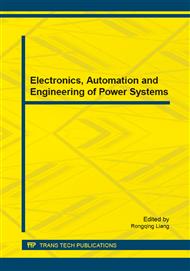[1]
Kathryn J. Dharmaraj, Chase D. Cox, Alvin M. Strauss, George E. Cook. Ultrasonic thermometry for friction stir spot welding[J]. Measurement, 2014, Vol. 4(9).
DOI: 10.1016/j.measurement.2013.11.054
Google Scholar
[2]
N. Fuhrmann,J. Brübach,A. Dreizler. Phosphor thermometry: A comparison of the luminescence lifetime and the intensity ratio approach[J]. Proceedings of the Combustion Institute, 2013, Vol. 34(2).
DOI: 10.1016/j.proci.2012.06.084
Google Scholar
[3]
Grattan K. T . V and Meggitt B T. Optical . Fiber Sensor Technology (London: Chapman and Hall) (Dordrecht: Kluwer–Academic) 1994, vols. 1-4.
Google Scholar
[4]
Collins S F, Baxter G W, Wade S A, Sun T, Zhang Z Y, Grattan K T V and Palmer A W . Comparison of fluo-rescence based temperature sensor schemes: theoretical analysis and experimental validation [J]. Appl. Phys. 2006, 84(8): 4649-54.
DOI: 10.1063/1.368705
Google Scholar
[5]
Wade S A, Collins S F and Baxter G W. The fluorescence intensity ratio tehnique for optical fiber temperature sensing[ J]. Appl Phys, 2003, 94(8): 4743-56.
DOI: 10.1063/1.1606526
Google Scholar
[6]
B G Koziol, G W Baxter and S F Collins. Dependence of fluorescence lifetime inpraseodymium-doped silica optical fibres upon strain and temperature[J]. Opt. 2010, 015407.
DOI: 10.1088/2040-8978/12/1/015407
Google Scholar
[7]
A. Babnik, and A. Kobe. ImProved Probe geometry for fluorescence-based fiber-optic temperature sensor[J]. Elsevier Seience, 1996: 203一207.
DOI: 10.1016/s0924-4247(97)80115-x
Google Scholar
[8]
Grattan K T V and Zhang Z Y . Fiber Optic Fluorescence Thermometry (London: Chapman and Hall)(1995).
Google Scholar
[9]
D. L. Donoho, and I. M. Johnstone, Ideal spatial adaption via wavelet shrinkage. Biometrika, 1994, 425-455.
DOI: 10.1093/biomet/81.3.425
Google Scholar
[10]
D. L. Donoho. Denoising by soft thresholding. IEEE Transactions on Information Theory, 1995, Vol. 41, No. 3, pp.613-627.
DOI: 10.1109/18.382009
Google Scholar
[11]
Yasser Ghanbari, Mohammad Reza Karami-Mollaei. A new approach for speech enhancement based on the adaptive thresholding of the wavelet packets. Speech Communication[J], 2006, Vol. 48: 927–940.
DOI: 10.1016/j.specom.2005.12.002
Google Scholar
[12]
Wang Kun, Zhang Xin-zheng, Wang Zhen-hua. Enhancement of SNR and precision in measurement of time resolved fluorescence spectra. Laser Techonlogy. [J], 2005, Vol . 29, No . 2.
Google Scholar


